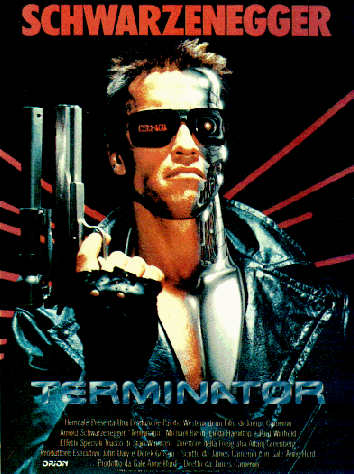

Summary
A cyborg is sent from the future on a deadly mission. He has to kill Sarah Connor, a young woman whose life will have a great significance in years to come. Sarah has only one protector - Kyle Reese - also sent from the future. The Terminator uses his exceptional intelligence and strength to find Sarah, but is there any way to stop the seemingly indestructible cyborg? Sarah will give birth to the man who will lead the humans against a robotic takeover, and this is why her life is threatened. If the terminator can kill Sarah Connor, the eventual mother of the human leader, then all of humanity will be terminated and replaced by machines. "The film replays an old and often-told story of modern society's 'technophobia,' the fear that our constructions might eventually shape our destruction." (Replications, Telotte, 171).
Technical Robot Description:
A cyborg, a machine, a terminator, Cyberdyne systems model one zero one. Infiltration unit. Underneath it's a hyper-alloy combat chassis. Microprocessor controlled, fully armoured. Very tough. But on the outside it's living human tissue.
Questions
1. What is the role/function of robot?
Why was it created?

The cyborgs, or terminators, are sent back in time to destroy John Connor, the leader of the human resistance. A lone protector was sent by the resistance to attempt to save John. Thus they are merely killing machines. In fact, they are machines sent from a future time when robots are taking over and humans are reduced to a rebellious group, whose leader's life is now in question.
2. How human is it? How human was it meant to be?
The terminators are very human-like and nearly indistinguishable from humans, save from a few screen shots at the inner workings of the machines. They act and think as humans, but perhaps a little slower and more mechanized. The killer cyborg "disconcertingly blends with humans: speaks our language, crudely follows our basic customs, acts in roughly effective ways. In fact, the film emphasizes just how easy it is to 'pass' for human in a world that judges that status so superficially." (Telotte, 172). The terminator has become almost undetectable from humans.
3. How well does it interact with society?
The terminators interact well with society and blend in almost undetectably. They make themselves obvious only on their attacks on humans and the display of indestructibility which shows itself upon attack. Arnold's terminator character is programmed with a limited set of verbal reponses that suggest how superficial much of our interaction has become. "He easily negotiates his way in our world: rents a room, acquires weapons, and gains the information needed to locate Sarah." (Telotte, 172).
4. What are the consequences within the context of the world of the work?
The Terminators leave a trail of destruction in their path, including a blown-up police station, an anti-authoritarian move, and show that man is susceptible to his own creations. The robots are attempting to replace human beings with themselves, and end up merely destroying each other.
5. Does it introduce a new idea or aid in the evolution of the robot? i.e. What is its contribution?
The contribution of The Terminator to the evolution of the robot furthers the notion that humanity sometimes is only operated on the superficial level. The Terminator cyborgs are able to assimilate into society virtually undetectable and interact as normal people until something gets in the way of their mission. The fear humankind has of losing control of its own inventions is a prevalent theme that is obvious from the start with the "The Terminator warns about a kind of technologically inspired way we have of judging the world and those in it on the basis of appearances, while it also cautions us about the basis of those appearances--how much they are simply constructed for us, without our awareness, and made to seem quite natural and transparent. No one nor no thing here is simply who or what it first seems. For this reason it is quite fitting that the Terminator makes no discriminations in carrying out its prime directive; it simply kills every Sarah Connor in the telephone book to make sure it gets the right one. The Terminator challenges us to look again, to look more deeply, to pay more attention to a world and a self we are, with our technology and our culture, constantly growing." (Telotte, 174).